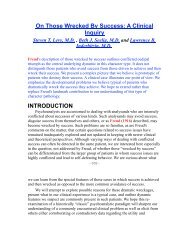A Sadomasochistic Transference - Beth J. Seelig, MD
A Sadomasochistic Transference - Beth J. Seelig, MD
A Sadomasochistic Transference - Beth J. Seelig, MD
Create successful ePaper yourself
Turn your PDF publications into a flip-book with our unique Google optimized e-Paper software.
to distance her from her siblings and her father. Although, for a long time, the<br />
patient complained she had no special place in the family, she,<br />
- 979 -<br />
in fact, described how she was her mother's phobic partner. Miss T. felt her mother<br />
used her in order to quiet her own anxiety. She recollected that mother was<br />
frightened to go to the basement to do the laundry and needed her to go along.<br />
Miss T. related her adult hate of doing the laundry to the fear her mother had of the<br />
basement. She described being bewildered by mother's insistence that she stay<br />
with her in the basement, and angry at not being allowed to go and play.<br />
Initially, Miss T. experienced the analysis as claustrophobic and controlling,<br />
like doing laundry with her mother. When Miss T. was older, she had to make<br />
telephone calls for her mother, since talking on the telephone made mother too<br />
anxious. The mother-daughter roles appeared to be reversed, with the child being<br />
called upon to calm the neurotic anxieties of the mother. In some ways, then,<br />
despite her demands, Miss T. unconsciously felt like her mother's chosen child, so<br />
long as she denied her own autonomous wishes, and "read" her mother's needs<br />
without any real expectation that her own subjective life was of concern to her<br />
mother. Being chosen for the special position of phobic partner was not initially<br />
recognized as being a source of gratification; this pleasure could only be<br />
acknowledged unconsciously after the analysis was well underway. (Miss T. never<br />
fantasized or theorized as to why she was the child so chosen.)<br />
While predominantly compliant, Miss T. intermittently raged at her mother,<br />
creating the first of her intense sadomasochistic bonds. She recollected intense<br />
battles with her mother in which she attempted to "prove" to her mother that she<br />
had been totally unwanted, or that she was "supposed to" be a boy. Mother battled<br />
with her over these issues, always insisting that she loved all of her children<br />
equally, though Miss T. remained unconvinced.<br />
The question naturally arises as to why Miss T. was unable to extricate herself<br />
from the tie to her mother, which she regarded as so damaging to herself. A child is<br />
often able to mobilize an in-depth bond to a third party as a way out of a<br />
"pathological" dyad. We believe several mechanisms acted to<br />
- 980 -<br />
perpetuate Miss T.'s hostile-dependent bond with her mother. From the child's<br />
point of view, as Fairbairn (1952) astutely remarked: "it is better to be a sinner in a<br />
world ruled by God than to live in a world ruled by the Devil" (pp. 66–67). Miss<br />
T., who regarded herself as a bad little girl, conceived the hope that her mother<br />
(and later the analyst) would turn out to be benevolent if only she could reform




